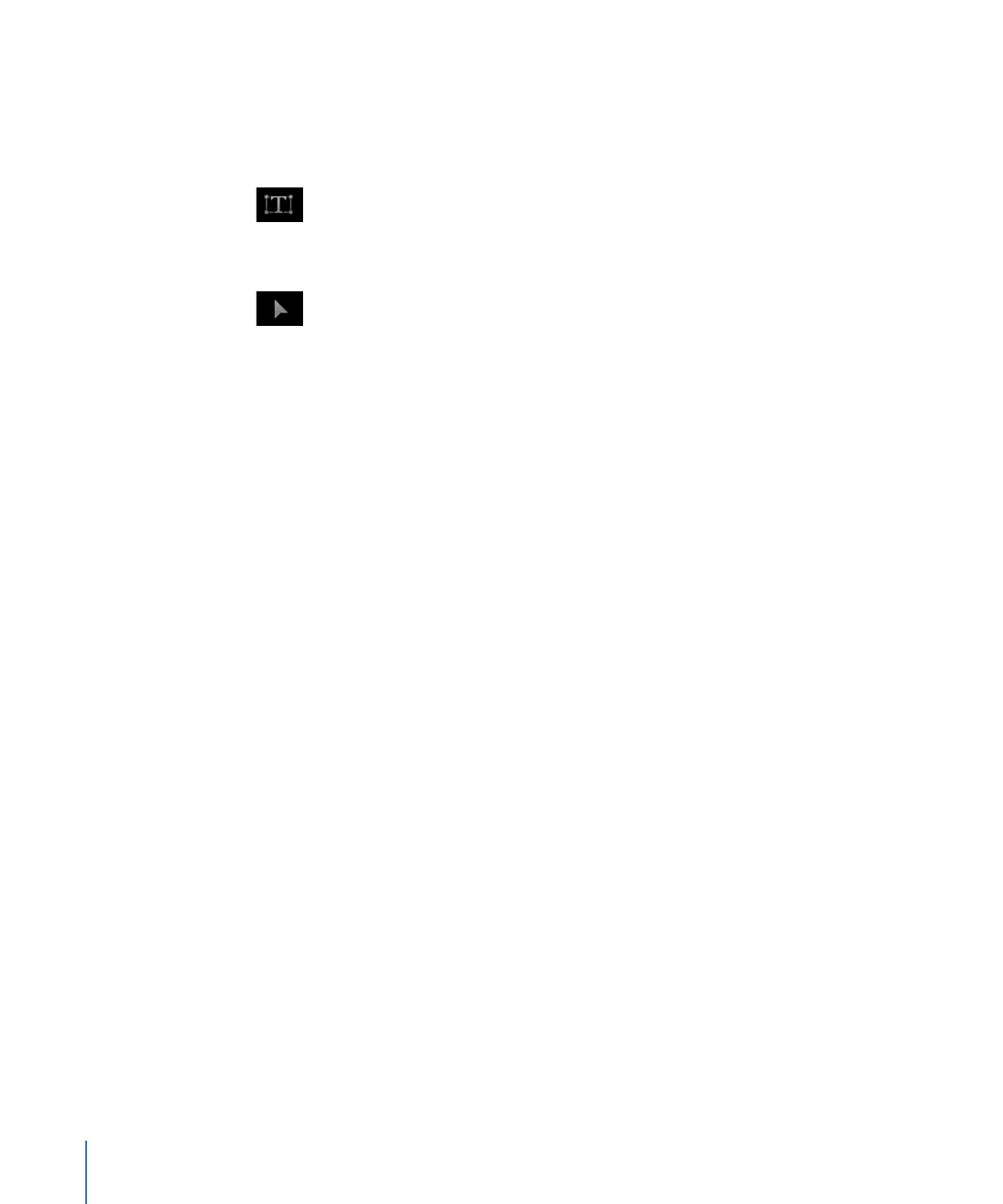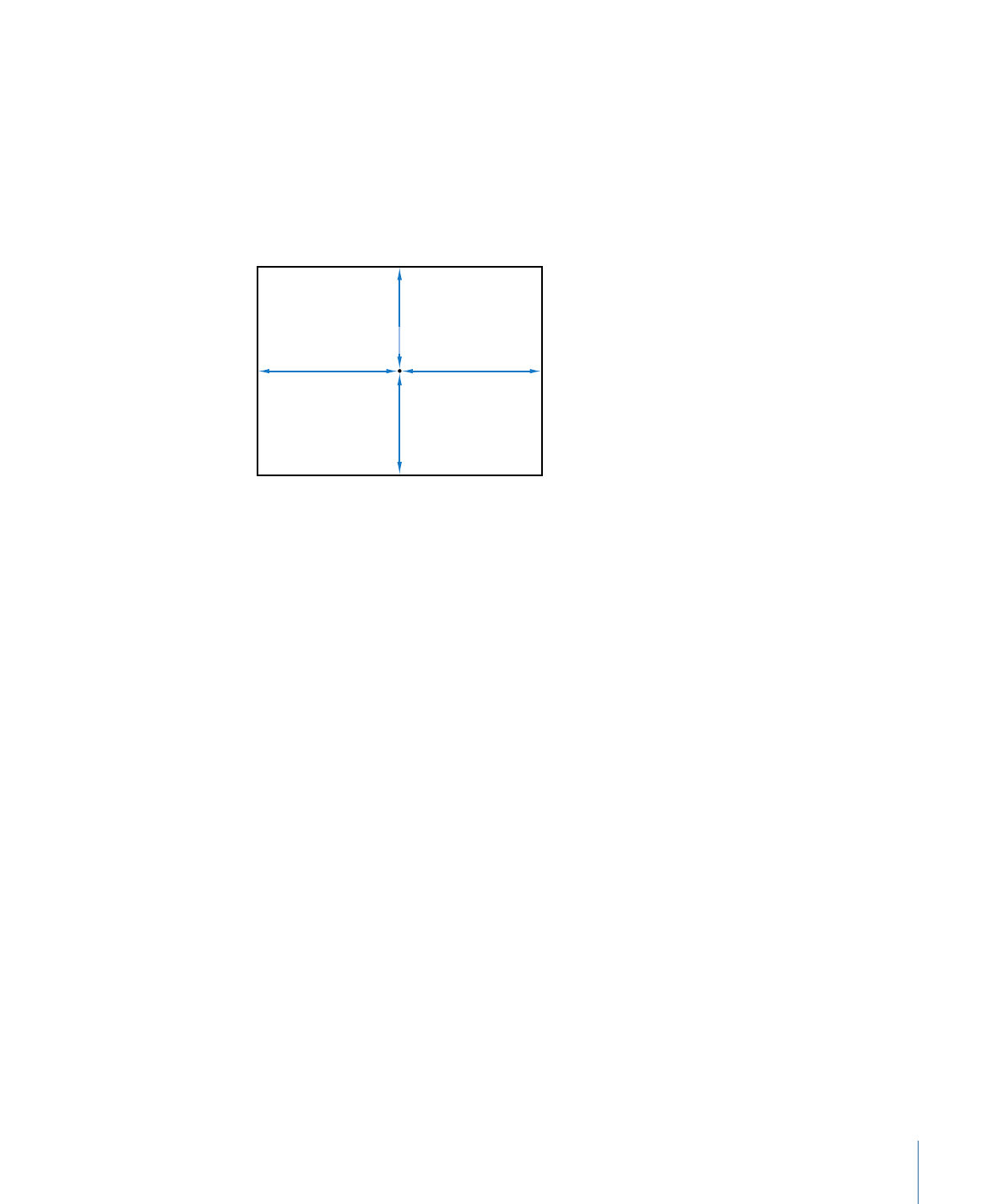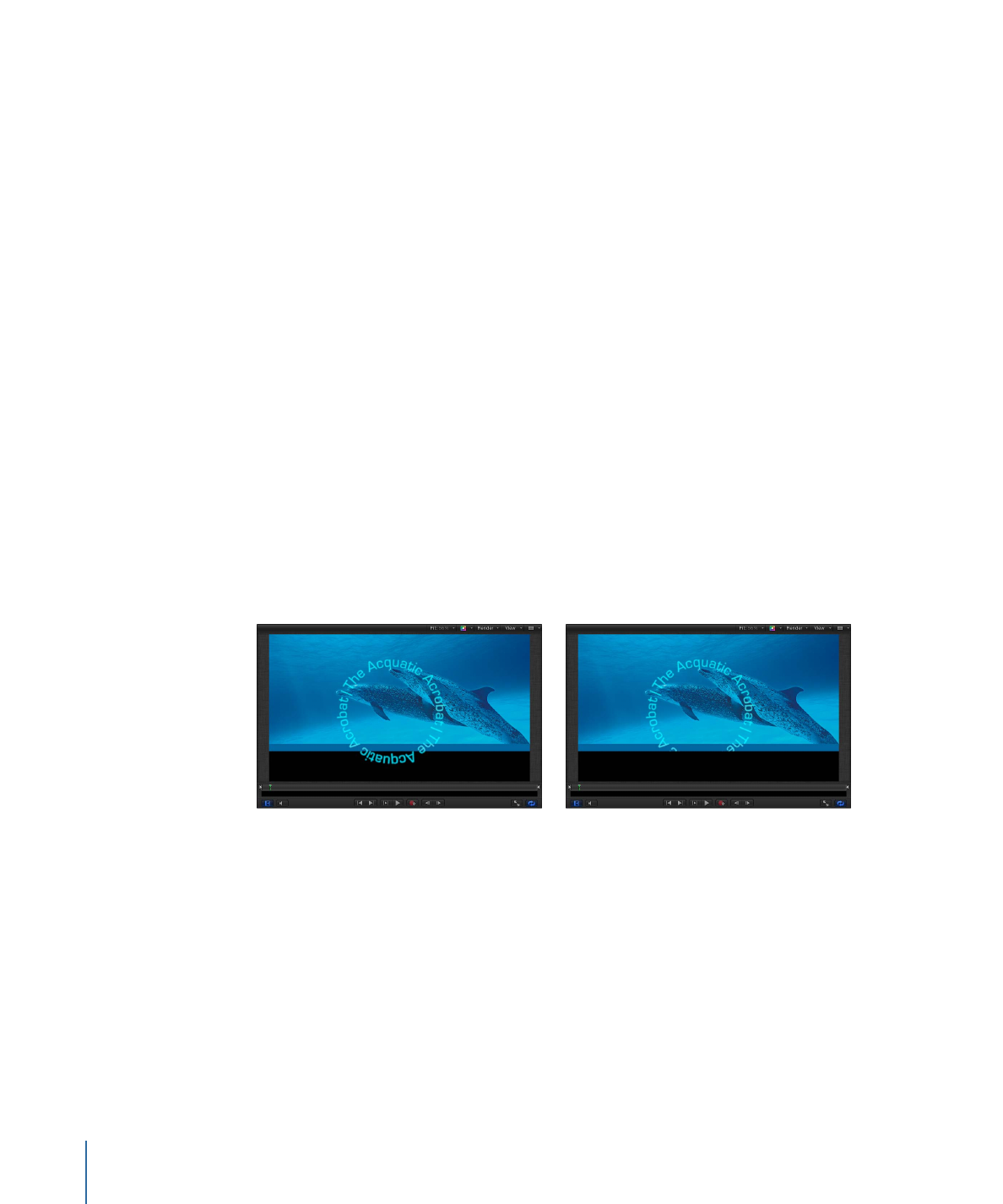
Parameters in the Properties Inspector
The Properties pane of the Inspector displays the following parameters for most layers
and groups:
280
Chapter 7
Basic Compositing

Transform Parameters
Position:
Defines the X (horizontal), Y (vertical), and Z (depth) position of each layer.
The coordinate system used by Motion specifies the center of the Canvas as 0, 0, 0
regardless of the frame size of the project. Moving a layer to the left subtracts from the
X value, while moving to the right adds to the X value. Moving a layer up adds to the Y
value, and moving a layer down subtracts from the Y value. Moving a layer closer adds
to the Z value, while moving further away subtracts from the Z value.
Canvas center point
(0,0)
-360 pixels
+360 pixels
+240 pixels
-240 pixels
Each layer’s position is centered on its anchor point. Offsetting the anchor point also
offsets the position of the layer relative to the X, Y, and Z position values you have set.
Rotation:
A dial that controls a one-dimensional value representing the number of degrees
of rotation around the Z axis. A positive value rotates the layer counterclockwise. A
negative value rotates the layer clockwise.
Rotating a layer beyond 360 degrees results in multiple rotations when the Rotation
parameter is animated.
Click the disclosure triangle next to the Rotation parameter to reveal dials that adjust
rotation around all three axes (X, Y, and Z), as well as the Animate pop-up menu.
• Animate: Allows you to set the interpolation for animated 3D rotation channels to one
of two options:
• Use Rotation: The default interpolation method. Layer rotates from its start angle to
their final angle. Depending on the animation, the layer might twist before reaching
its final orientation (the last keyframed value). For example, if the X, Y, and Z Angle
parameters are animated from 0 degrees to 180 degrees in a project, the layer rotates
on all axes before reaching its final orientation.
• Use Orientation: This alternate interpolation method provides smoother interpolation
but does not allow multiple revolutions. Use Orientation interpolates between the
layer’s start orientation (first keyframe) to its end orientation (second keyframe).
Note: The Rotation parameter must be keyframed for the Animate parameter options
to have any effect.
281
Chapter 7
Basic Compositing

Scale:
A slider that controls the percentage representing the layer’s scale, relative to its
original size. By default, the horizontal and vertical scale of a layer is locked to the layer’s
original aspect ratio—represented by a single percentage. Click the disclosure triangle
to display independent percentages for the X, Y, and Z scales of the layer.
Note: Setting a layer’s scale to a negative value flips the layer.
Shear:
Value sliders that defines the X and Y shear of the layer. A layer with no shear has
X and Y shear values of 0. Positive values shear in one direction, while negative values
shear in the other.
Anchor Point:
Value sliders that define the X and Y position of the anchor point relative
to the center of the layer. Coordinates of 0, 0 center the anchor point in the bounding
box defining the outer edge of the layer. Click the disclosure triangle to expose an
additional value slider defining the Z position.
Blending Parameters
Opacity:
A slider that sets the transparency of the layer. For more information, see
Editing
Opacity and Blending Parameters
.
Blend Mode:
A pop-up menu that sets the Blend Mode of the layer. For more information,
see
Editing Opacity and Blending Parameters
.
Preserve Opacity:
When this checkbox is selected, the layer appears only where another
layer is visible behind it in the composite. The front layer uses the opacity value of the
layer behind it. For more information, see
Preserve Opacity Option
.
Preserve Opacity enabled
Preserve Opacity disabled
Casts Reflections:
A pop-up menu that determines whether a layer casts a reflection.
Choose from three options:
Note: Reflections are only visible when layers are in a 3D group. For more information
on 3D groups, see
3D Group Properties
.
• Yes: The layer is seen reflected in nearby reflective layers.
• No: The layer is ignored by reflective surfaces.
• Reflection Only: The layer becomes invisible, but will appear in reflective surfaces around
it.
282
Chapter 7
Basic Compositing

The following three parameter groups in the Properties Inspector—Lighting, Shadows,
and Reflection—appear only when the parent group is set to 3D.
Lighting Parameters
Shading:
A pop-up menu that sets how a layer responds to lights in the scene. There are
three options:
• Inherited: The layer uses the shading value of its parent.
• On: The layer can be lit.
• Off: The layer ignores scene lights.
Highlights:
When this checkbox is selected, lit layers in the scene show highlights. This
parameter has no effect if Shading is set to Off. Click the disclosure triangle to reveal an
additional Shininess parameter.
• Shininess: A slider that sets how strong a layer’s highlights appear. Higher values create
a glossier appearance.
For more information on using lights, see
Lighting
.
Shadows Parameters
Cast Shadows:
A checkbox that sets whether a shadow is cast when a layer lies between
a light source and another layer.
Note: This parameter does not affect drop shadows.
Receive Shadows:
Controls whether neighboring layers’ shadows affect the current layer.
When this checkbox is deselected, light affects the layer as if the shadow-casting layer
did not exist.
Shadows Only:
A checkbox that, when selected, specifies that a layer blocks light and
casts a shadow, while the layer itself does not appear in the scene.
Note: For more information on using shadows, see
Shadows
.
Reflection Parameters
Reflectivity:
A slider that controls the shininess of the layer’s surface. When set to 0%,
there is no reflectivity. When set to 100%, the layer is totally reflective, like a mirror.
Blur Amount:
A slider that controls how blurry the reflection appears, creating the
appearance of soft focus due to the surface quality of the reflecting layer.
Falloff:
A checkbox that controls whether the reflection fades with distance from the
layer, producing a more realistic result. Click the disclosure triangle to show additional
controls that adjust the falloff effect: Begin Distance, End Distance, and Exponent. The
Exponent slider adjusts how quickly the reflection becomes fainter as reflected layers
move away from the reflecting layer.
Blend Mode:
A pop-up menu that determines the blend mode used for the reflection.
Note: For more information on using reflections and their parameters, see
Reflections
.
283
Chapter 7
Basic Compositing

Additional Lighting, Shadows, and Reflection Restrictions
The Lighting, Shadows, and Reflection parameter groups have several additional
restrictions. Use the following guidelines when working with lights and reflections:
• The Reflection parameter group is not available for 3D particle emitters or 3D
replicators.
• The Reflection parameter group is not available for normal text layers. However, the
Reflection parameters are available for flattened text, which is activated by the Flatten
checkbox in the Layout pane of the Text Inspector.
Additional Parameters in the Properties Inspector
Drop Shadow:
Turns the drop shadow of a layer on and off. For more information about
working with drop shadows, see
Drop Shadows
.
Four Corner:
Click the activation checkbox to turn distorting on and off. If a layer is
distorted and this checkbox is deselected, the layer resumes its original shape, although
the distorted coordinates are maintained. Reselecting the checkbox re-enables the distort
effect specified by the Four Corner coordinate parameters.
Value sliders modify the X and Y coordinates of the layer’s four corner points (Bottom
Left, Bottom Right, Top Right, and Top Left).
You can also control these parameters visually in the Canvas using the Distort tool. For
more information, see
2D Transform Tools
.
Crop:
Click the activation checkbox to turn cropping on and off. If a layer is cropped and
this checkbox is deselected, the layer resumes its original size, although the cropping
values are maintained. Reselecting the checkbox re-enables the cropping effect specified
by the crop parameters.
Adjust the four sliders to modify the crop parameters. Each slider defines the number of
pixels to be cropped from the layer’s four sides, relative to the outer edge of the bounding
box that surrounds it. These parameters are similar to the crop parameters in the Media
Inspector (available when you select a layer in the Media list). However, whereas cropping
a layer via the Media Inspector crops all instances of that layer in your project, cropping
a layer in the Properties Inspector crops only a single instance of the layer; duplicates of
the layer remain uncropped. For more information, see
Media Inspector
.
Timing:
These parameters control all aspects of clip retiming. For more information, see
Retiming
.
284
Chapter 7
Basic Compositing